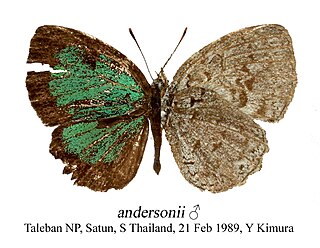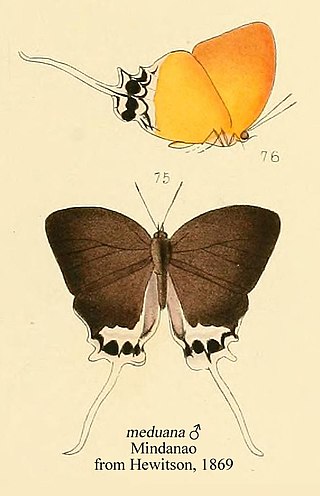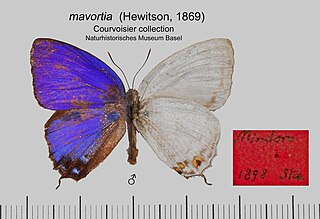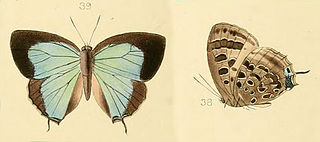
Poritia phalena, the broad-banded brilliant, is a small butterfly found in India and South-East Asia that belongs to the lycaenids or blues family. The species was first described by William Chapman Hewitson in 1874.

Poritia is a genus of lycaenid butterflies. The species of this genus are found in the Indomalayan realm. Poritia was erected by Frederic Moore in 1887.

Cyaniriodes is a genus of butterflies in the family Lycaenidae. The genus was erected by Lionel de Nicéville in 1890.

Hypochlorosis is a genus of butterflies in the family Lycaenidae. The species of this genus are found on New Guinea and in the Moluccas in the Australasian realm.

Manto is a monotypic genus of butterflies in the family Lycaenidae. Its sole species, Manto hypoleuca, is found in the Indomalayan realm.

Paruparo is a genus of butterflies in the family Lycaenidae. The species of this genus are found in the Indomalayan realm.

Tajuria is an Indomalayan genus of butterflies in the family Lycaenidae.

Rachana is a genus of butterflies in the family Lycaenidae.

Paruparo mio is a butterfly of the family Lycaenidae first described by Hisakazu Hayashi, Heinz G. Schroeder and Colin G. Treadaway in 1984. It is endemic to the Philippine island of Mindanao. Forewing length: 16–17 mm. It is a quite rare species and the threat category is "vulnerable".

Tajuria deudorix yuhkichii is a subspecies of the butterfly Tajuria deudorix in the family Lycaenidae. The subspecies was first described by Hisakazu Hayashi in 1984. It is found in Palawan in the Philippines.

Paruparo cebuensis is a species of butterfly in the family Lycaenidae. It is found in the Philippines.

Arhopala aronya is a species of butterfly in the family Lycaenidae first described by William Chapman Hewitson in 1869. Its forewing length is 17–18 mm. It is endemic to the Philippines. It is uncommon or local.

Ocaria ocrisia, the black hairstreak or Hewitson's blackstreak, is a butterfly of the family Lycaenidae. It was described by William Chapman Hewitson in 1868. It is found from Mexico to Brazil, Paraguay, Peru, Ecuador and Argentina. It has also been recorded in southern Arizona. The habitat consists of rainforests at altitudes ranging from 200 to 900 meters.

Arhopala corinda is a species of butterfly belonging to the lycaenid family described by William Chapman Hewitson in 1869. It is found in Southeast Asia.

Eooxylides meduana is a butterfly in the family Lycaenidae. It was described by William Chapman Hewitson in 1869. It is found in the Philippines.

Arhopala myrzala is a butterfly in the family Lycaenidae. It was described by William Chapman Hewitson in 1869. It is found in the Indomalayan realm.

Drina mavortia is a butterfly in the family Lycaenidae. It was described by William Chapman Hewitson in 1869. It is endemic to the Philippines in the Indomalayan realm.

Tajuria deudorix is a species of lycaenid or blue butterfly found in the Indomalayan realm

Arhopala hesba is a butterfly in the family Lycaenidae. It was described by William Chapman Hewitson in 1869. It is found in the Indomalayan realm where it is endemic to the Philippines.

Arhopala ocrida, is a butterfly in the family Lycaenidae. It was described by William Chapman Hewitson in 1869. It is found in the Indomalayan realm where it is endemic to the Philippines. Subspecies A. ocrida cionnii is described from the Sula Islands.




















